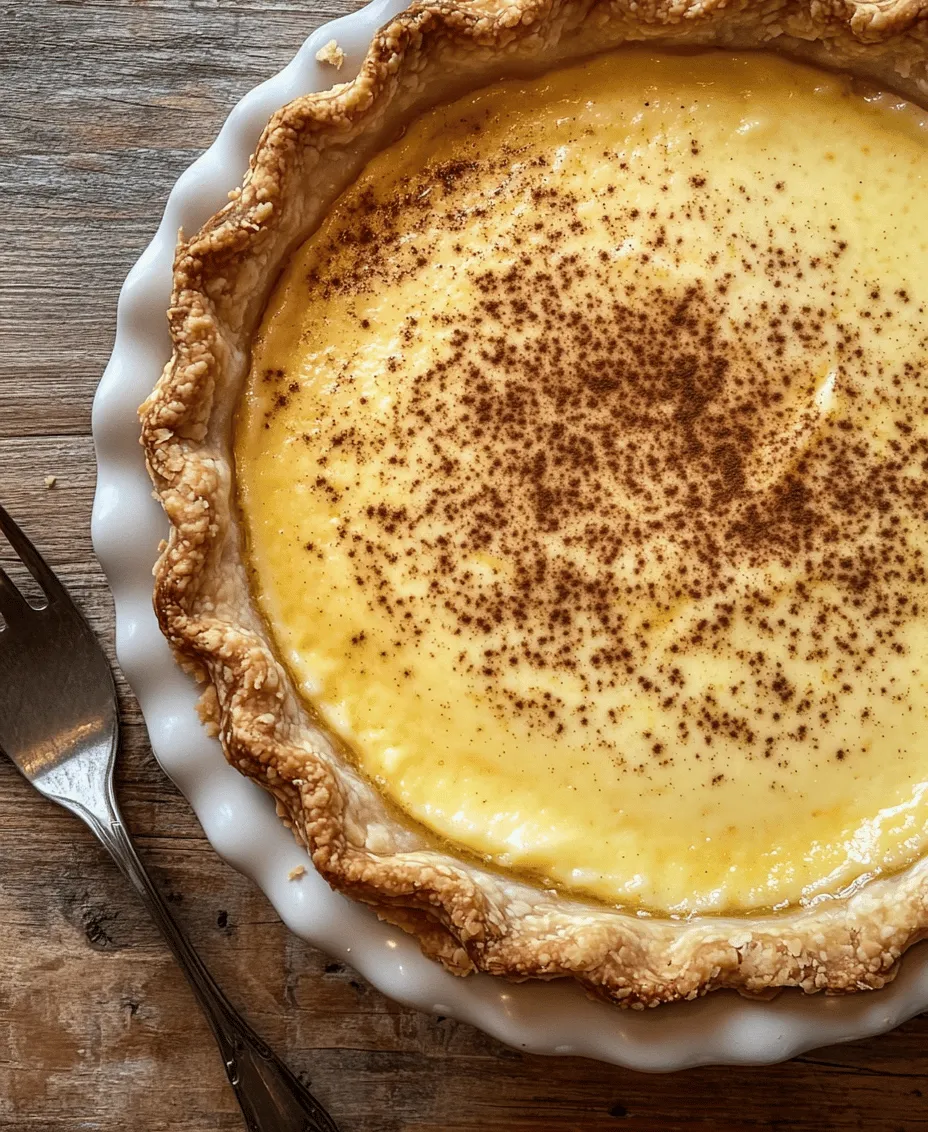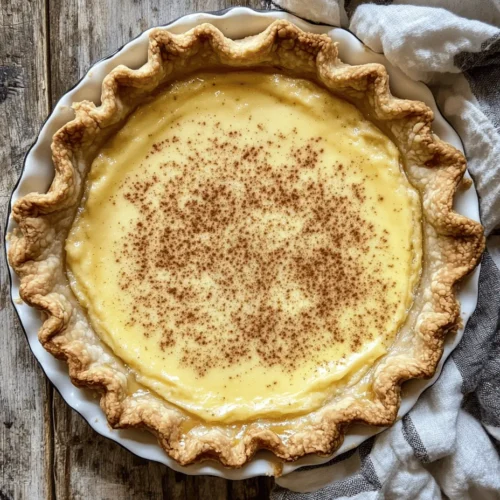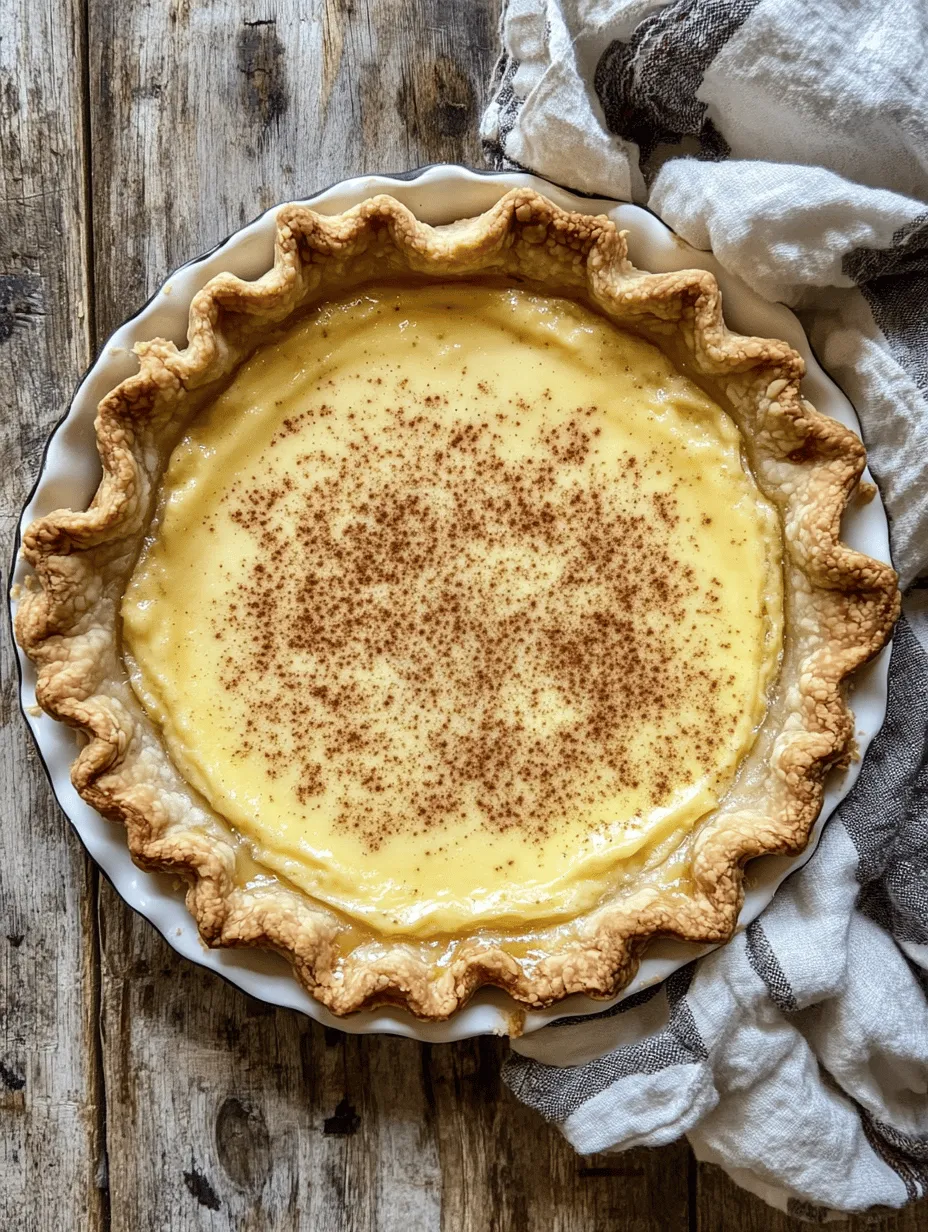In the realm of traditional desserts, few treats evoke nostalgia quite like a classic egg custard pie. This timeless recipe combines simple ingredients to create a rich, creamy filling nestled in a flaky crust, making it a beloved staple at family gatherings and holiday celebrations. The allure of egg custard pie lies in its comforting flavors and easy preparation, making it a go-to dessert for both novice bakers and seasoned cooks alike. In this article, we dive deep into the history, preparation, and enjoyment of egg custard pie, offering you a comprehensive guide to mastering this delightful dessert.
The History of Egg Custard Pie
Exploring the Origins of Egg Custard Pie
The existence of egg custard pie can be traced back to the early days of American cooking, where simple and hearty meals were the foundation of family gatherings. While the exact origins of egg custard pie are somewhat murky, it is believed that the dish has roots in both European and early American culinary traditions. The basic concept of custard—combining eggs, milk, and sugar—was popular in many European cuisines long before it found its way into American kitchens.
Custard as a dessert has been enjoyed in various forms for centuries, with recipes appearing in English cookbooks as far back as the 17th century. As settlers brought their culinary traditions to America, the egg custard pie emerged as a unique adaptation, making use of local ingredients and reflecting the resourcefulness of home cooks. This evolution showcases how traditional recipes can adapt and persist through generations, becoming an integral part of cultural identity.
Understanding the Cultural Significance
Egg custard pie is more than just a dessert; it symbolizes comfort, family, and tradition. For many, it evokes memories of gathering around the kitchen table with loved ones, sharing stories and laughter over a slice of pie. Its creamy texture and sweet flavor have made it a staple at holiday dinners, potlucks, and special occasions, bridging generations of family recipes and memories.
In Southern cuisine, egg custard pie holds a particularly cherished place, often associated with hospitality and the warmth of home-cooked meals. It is not uncommon to find variations of the recipe passed down through families, each version carrying with it a unique story or twist. The simplicity of the ingredients allows for individual creativity, making it a beloved dish that offers both familiarity and room for personalization.
Evolution of the Recipe Through Generations
As culinary trends have evolved, so too has the egg custard pie recipe. While the classic version remains popular, modern adaptations have emerged to cater to diverse tastes and dietary preferences. Some bakers opt for alternative crusts, such as graham cracker or nut-based crusts, while others experiment with flavorings like chocolate or fruit purees to give the traditional pie a contemporary twist.
Despite these innovations, the essence of the classic egg custard pie remains unchanged. The core ingredients—eggs, sugar, milk, and vanilla—combine to create a smooth custard that is both satisfying and indulgent. This dessert’s enduring popularity speaks to its timeless appeal, proving that sometimes, the simplest recipes are the most cherished.
Ingredients Overview
Essential Components of Classic Egg Custard Pie
To create a classic egg custard pie, you will need a handful of essential ingredients that work together to produce a deliciously creamy and flavorful filling. Here’s a closer look at each component:
– The Role of Eggs: The Foundation of the Custard
At the heart of any custard pie lies the eggs, which serve as the primary binding agent for the filling. Eggs provide structure and stability while also contributing to the rich, creamy texture that defines a perfect custard. When beaten and combined with other ingredients, eggs create a luscious mixture that, when baked, transforms into a smooth and velvety filling.
– The Sweetness Factor: Granulated Sugar Explained
Sugar plays a crucial role in balancing the flavors of the custard. Granulated sugar not only sweetens the filling but also helps to enhance the overall taste profile. The key is to find the right balance, as too much sugar can overwhelm the delicate flavors of the eggs and milk. Typically, a cup of granulated sugar is sufficient for a standard pie, providing a perfect level of sweetness without being cloying.
– The Creaminess of Whole Milk
Whole milk is essential for achieving the desired creaminess in your egg custard filling. Its fat content contributes to the rich mouthfeel and helps create a smooth texture. While some recipes may suggest using half-and-half or heavy cream for a more decadent custard, whole milk strikes the perfect balance between richness and lightness.
– Enhancing Flavor: Vanilla Extract, Nutmeg, and Cinnamon
Flavoring is what transforms a simple custard into a standout dessert. Pure vanilla extract is a classic addition that complements the sweetness of the pie, while spices like nutmeg and cinnamon add warmth and depth to the flavor profile. A pinch of nutmeg sprinkled on top before baking not only enhances the aroma but also adds an inviting visual appeal.
– The Importance of Salt in Balancing Sweetness
A small amount of salt is often overlooked in dessert recipes, but it plays a vital role in balancing sweetness and enhancing flavors. Just a pinch of salt can elevate the overall taste of the custard, making it more complex and satisfying. It acts as a flavor enhancer, bringing out the best in the other ingredients.
– The Convenience of Pre-Made Pie Crust
While making a pie crust from scratch can be rewarding, using a pre-made pie crust simplifies the preparation process without sacrificing quality. A store-bought crust allows you to focus on perfecting the custard filling, making this recipe accessible for bakers of all skill levels. Choose a high-quality crust for the best results, or if you’re feeling adventurous, consider making your own from scratch.
Step-by-Step Preparation Guide
Preheating the Oven
Before diving into the preparation of your egg custard pie, it’s essential to preheat your oven. Preheating ensures that the custard will bake evenly, resulting in a smooth and creamy texture. The ideal temperature for baking egg custard pie is typically set at 350°F (175°C). This moderate heat allows the custard to set without overcooking, which can lead to a rubbery or curdled texture.
– Importance of Temperature in Baking
Proper temperature control is crucial in baking, especially for custard-based desserts. If the oven is not preheated adequately, the custard may not cook evenly, leading to varying textures within the pie. A well-preheated oven provides consistent heat throughout the baking process, ensuring that the custard sets perfectly.
– Ideal Baking Conditions for Custard
Baking egg custard pie in a water bath can help maintain even temperature and moisture during cooking. A water bath, or bain-marie, involves placing the pie dish in a larger pan filled with hot water. This technique helps prevent the edges from cooking too quickly while allowing the custard to set gently, resulting in a creamy, smooth pie.
Preparing the Pie Crust
If you’re using a pre-made pie crust, it’s important to prepare it correctly to ensure a successful final product.
– How to Properly Thaw a Frozen Pie Crust
If you’re using a frozen pie crust, allow it to thaw completely before filling. This can typically be done by placing it in the refrigerator for a few hours or leaving it at room temperature for about 30 minutes. Ensure the crust is fully thawed to avoid a soggy bottom after baking.
– Techniques to Prevent Bubbling in the Crust
To prevent bubbling in the crust during baking, you can dock the crust with a fork before filling it. Docking involves pricking small holes in the bottom and sides of the crust, allowing steam to escape as it bakes. This will help the crust maintain its shape and texture, providing a sturdy base for the custard filling.
Whisking the Eggs
Once your crust is prepared, it’s time to focus on the custard filling. The key to a perfect egg custard lies in the whisking of the eggs.
– Achieving the Perfect Egg Mixture: Tips for Whisking
Begin by cracking the eggs into a mixing bowl. Use a whisk or electric mixer to beat the eggs until they are well combined and frothy. This process incorporates air into the mixture, resulting in a lighter custard. Aim for a smooth, homogeneous mixture without any streaks of egg whites.
– The Science Behind Beaten Eggs in Custard
When eggs are beaten, their proteins begin to unfold and interact with one another. As the custard bakes, these proteins coagulate, forming a delicate network that holds the custard together. Properly whisking the eggs ensures that the custard will set correctly, resulting in a smooth and creamy filling.
Mixing the Ingredients
After whisking the eggs, it’s time to combine the remaining ingredients to create the custard mixture. Carefully add the granulated sugar, whole milk, vanilla extract, and a pinch of salt to the beaten eggs.
Stir the mixture gently until all the ingredients are well incorporated, ensuring the sugar is fully dissolved. If desired, you can also add a sprinkle of nutmeg or cinnamon at this stage for an extra layer of flavor.
Once the custard mixture is smooth, pour it into the prepared pie crust, taking care not to overfill. Leave a small amount of space at the top, as the custard may expand slightly during baking.
With your oven preheated, pie crust prepared, and custard mixture ready, you are well on your way to creating a classic old-fashioned egg custard pie that is sure to delight your family and friends.
Stay tuned for the next part of this article, where we will discuss the baking process, tips for achieving the perfect custard pie, and answers to some common questions about this beloved dessert.

Gradual Sugar Incorporation: Why It Matters
When creating a classic old-fashioned egg custard pie, the method of incorporating sugar into your mixture can significantly impact the final texture. Gradual sugar incorporation allows the sugar to dissolve uniformly, preventing any gritty texture in the custard. Begin by whisking your eggs until they are well blended; then, slowly add the sugar while continuously whisking. This technique not only ensures that the sugar is evenly distributed but also helps to aerate the mixture, which contributes to a lighter, creamier custard.
Achieving Smoothness with Whole Milk
Using whole milk in your egg custard pie recipe is essential for achieving that classic creamy texture that makes this dessert so delightful. Whole milk not only adds richness but also enhances the mouthfeel of the custard. Its higher fat content helps create a smooth and velvety consistency, which is crucial for a successful pie. If you prefer a slightly lighter option, you can substitute half-and-half or even a combination of milk and cream, but this may alter the flavor and texture slightly.
Flavoring the Custard
Balancing Flavors with Vanilla Extract
Vanilla extract is a must-have ingredient in any egg custard pie. It adds depth and a warm, aromatic flavor that balances the sweetness of the sugar and the richness of the eggs. For the best results, use pure vanilla extract rather than imitation vanilla for a more authentic taste. Typically, about one teaspoon is sufficient for a standard pie, but feel free to adjust according to your taste preferences.
The Role of Nutmeg and Cinnamon in Traditional Recipes
Incorporating spices like nutmeg and cinnamon is what gives classic egg custard pie its signature flavor profile. Nutmeg, with its warm, slightly sweet, and nutty notes, is often sprinkled on top of the custard before baking. It complements the creamy texture beautifully. A pinch of cinnamon can also be added to the custard mixture itself, introducing a subtle warmth that enhances the overall taste. Just be cautious with the amount; a little goes a long way, and you want the spices to enhance rather than overpower the custard’s delicate flavors.
Pouring the Custard into the Crust
Once your custard mixture is perfectly blended and flavored, it’s time to pour it into the prepared pie crust. To avoid spills and ensure even distribution, use a ladle or a measuring cup with a spout. This will give you more control as you pour. Start by filling the crust in the center, allowing the custard to flow outward. This method minimizes the chances of sloshing and helps maintain a clean edge on your crust.
Baking Instructions
Timing and Temperature: Key to a Perfect Custard
Baking your egg custard pie requires precision. Preheat your oven to 350°F (175°C). Place the pie on the middle rack and bake for approximately 45 to 50 minutes. The cooking time may vary slightly based on your oven and the thickness of your custard. It’s vital to keep an eye on the pie as it bakes, ensuring the crust doesn’t over-brown. If you notice it browning too quickly, you can cover the edges with aluminum foil.
Knowing When the Custard is Done: The Knife Test
To check if your custard is fully set, perform the knife test. Insert a clean knife into the center of the custard; if it comes out clean or with just a few moist crumbs, your pie is done. The center may still have a slight jiggle, but it will firm up as it cools. Be careful not to overbake, as this can result in a rubbery texture instead of the smooth custard you desire.
Cooling and Setting the Pie
The Importance of Cooling Before Serving
After baking, it’s essential to let your egg custard pie cool at room temperature for at least one hour. This cooling period allows the custard to set properly, which is crucial for achieving the perfect slice. Cutting into a warm pie can lead to a runny custard, so patience is key.
Refrigeration Time: Why Patience is Key
Once the pie has cooled to room temperature, cover it with plastic wrap or aluminum foil and place it in the refrigerator. Ideally, you should allow it to chill for at least four hours, although overnight is even better. This resting period not only helps the flavors meld but also ensures the custard is fully set, making slicing easier and cleaner.
Serving Suggestions
How to Garnish Your Egg Custard Pie
When it comes to serving your egg custard pie, a simple garnish can elevate its presentation. A light dusting of freshly grated nutmeg on top can enhance its aroma and add a touch of elegance. Alternatively, you can serve it with a dollop of whipped cream or a scoop of vanilla ice cream for added richness. Consider using a fresh mint sprig for a pop of color and a hint of freshness.
The Impact of Ground Nutmeg on Presentation and Flavor
Ground nutmeg is not only a traditional spice in egg custard pie but also an excellent way to enhance both flavor and presentation. A sprinkle on top before serving adds visual appeal and complements the custard’s creamy texture. Make sure to use fresh nutmeg for the best flavor.
Ideal Serving Temperatures: Cold vs. Room Temperature
Egg custard pie can be served either cold or at room temperature, depending on your preference. Some people enjoy the refreshing chill of a cold slice, while others prefer the comforting warmth of a pie that has been allowed to sit out for a bit. Either way, it’s best to slice the pie with a sharp knife to ensure clean edges.
Pairing Ideas with Egg Custard Pie
Beverages that Complement the Richness
When it comes to beverages, consider pairing your egg custard pie with a rich cup of coffee or a warm glass of chai. The spices in chai can beautifully complement the flavors of the pie, while coffee’s bitterness balances the dessert’s sweetness. For a non-caffeinated option, a cup of herbal tea, such as chamomile or vanilla, can also be a delightful pairing.
Other Desserts that Harmonize with Custard Pie
If you’re serving egg custard pie at a gathering, consider complementing it with other desserts that harmonize well. A light fruit salad, for example, can provide a refreshing contrast to the creamy custard. Alternatively, a slice of tart lemon meringue pie can offer a delightful contrast in flavors and textures.
Nutritional Information
Caloric Breakdown per Serving
Understanding the nutritional value of your homemade egg custard pie can help you enjoy it guilt-free. One slice of this classic pie typically contains around 250-300 calories, depending on the size of the slice and the specific ingredients used. The primary contributors to the calorie count are the eggs, milk, sugar, and pie crust.
Understanding the Nutritional Value of Ingredients
The ingredients in egg custard pie offer a range of nutritional benefits. Eggs provide high-quality protein and essential vitamins, including B12 and D. Whole milk adds calcium and healthy fats, while a moderate amount of sugar enhances flavor without overwhelming the dish. While this dessert is indulgent, it can be enjoyed as part of a balanced diet.
Balancing Indulgence with Nutrition
While egg custard pie is a treat, enjoying it mindfully can allow you to indulge without compromising your nutritional goals. Consider savoring a smaller slice with a side of fresh fruit for a well-rounded dessert experience. Remember, it’s all about balance and enjoying the flavors of this beloved classic in moderation.
Conclusion: The Timeless Appeal of Egg Custard Pie
Classic old-fashioned egg custard pie is more than just a dessert; it’s a cherished recipe that brings warmth and comfort to gatherings. With its simple yet rich flavors, this pie is a testament to the beauty of home cooking and the joy of sharing sweet moments with loved ones. By mastering this recipe, you not only create a delicious treat but also keep alive a piece of culinary history. Enjoy the process of baking and savor every slice of this delightful custard pie, making it a centerpiece for your next gathering or a comforting dessert for a quiet evening at home.



